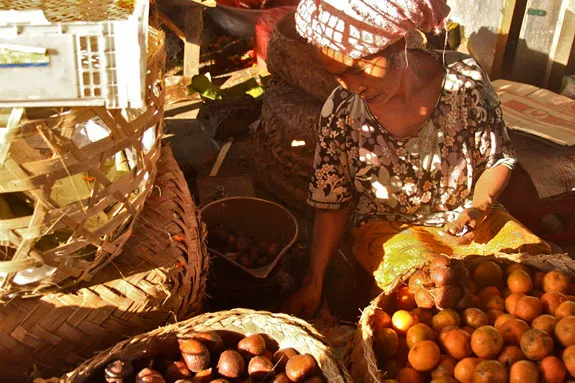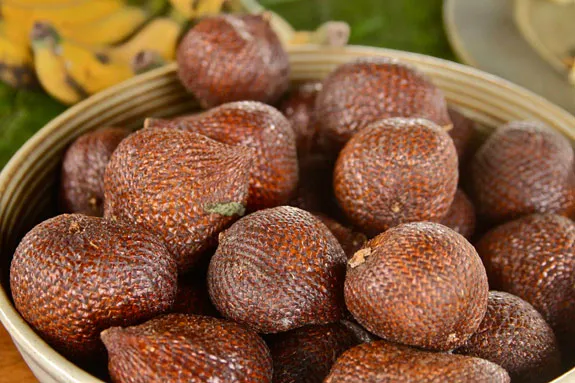Meet the Salak, the Ubiquitous Indonesian Fruit You’ve Never Heard Of
It may not be the biggest or brightest of southeast Asian fruits, but the snakefruit is the locals snack of choice
/https://tf-cmsv2-smithsonianmag-media.s3.amazonaws.com/filer/20121109082128snakefruit-salak-small1.jpg)
At a morning market in Bali, the usual gaudy suspects – papayas, mangos, dragon fruit and heaps of rancid-smelling durians - are on display. For Western visitors seeking culinary novelty, however, the most enticing fruit likely will not be the biggest or the brightest, but a humble, shiny brown offering called the salak. For the uninitiated, this fleshy, spongey morsel offers a perfumed cocktail of bright flavors, with hints of pineapple, citrus, honey and possibly even soap.
In Indonesia, salaks are as common as apples or oranges in the U.S. Also called snakefruit, this strawberry-sized, fig-shaped fruit comes encased in vivid, nutty-brown scales, not unlike that of a cobra or python. Heaps of salaks turn up daily at countless local markets, while touristy hotels offer them up in breakfast buffet lines as examples of typical island fare. The odd but ubiquitous morsels can be boiled with sugar into a sweet spread, pickled, vacuum dried and fried into chips or paired with other fruits and nuts, but locals prefer them best raw and straight off the tree.
At the daily market in Padang Bai, a sleepy backpacker haunt on Bali’s southeastern coast, Tutu Aldi Wan, a friendly local who works as a chef at the Bloo Lagoon Ecotourism Village, gives a salak-eating tutorial soon after dawn. “Sorry, I just woke up,” he yawns. “It was a big party last night.” He leads us past the stalls of those less intriguing papayas and mangoes, stopping in front of a woman sitting amidst baskets brimming with salaks. Her name is Monsaro, she says, and she comes each day to the market to sell her salaks from a farm about three miles away.

“First you open the snake skin,” he says, plucking up one of Monsaro’s salaks and making quick work of its covering. Inside, lobes of garlic-like meaty fruit await. “Then, clean off the little skin,” he instructs, indicating a thin, film-like coating encasing each segment of the yellowish white fruit, like that found on a boiled egg. “The white salaks are the best,” he shrugs, handing us the more-yellow-than-white fruit. We pucker up at the salak’s unfamiliar acidity and spongy texture, which leaves our mouths seemingly both dry and full of citrusy juices at the same time. Within each lobe, a few more nibbles expose a large, dull seed in the same shade of brown as the snakefruit’s exterior.
Salaks grow in bundles on palm-like plants with vicious spiked leaves and stems, and Indonesians often surround their yards with the primordial bushes, which double as purveyors of tasty treats and deterrents to would-be trespassers. On Java, traditional dancers whip themselves into a trance in the “Kuda Lumping” dance, then stomp upon or lick salak leaves to show their immunity to pain.
Around 30 types of snakefruits grow throughout their native Indonesia, but the islands of Bali and Java vie for the best salak around. Naturally, locals tend to swear by their own island fruit’s superiority, but for foreigners all bets are off, and preference is simply a matter of taste. The Javanese variety, or salak pondoh, is the more obnoxiously aromatic of the two varieties. This intense fruit walks a fine line of ripeness that is so volatile that it will often become overripe and sweaty even before it reaches maturation.

In Bali, salak bali delivers a crunchy, starchy experience that conjures associations with watery pineapple and lemon. One strain of extra small, extra sweet salak bali called gula pasir (“sand sugar”), fetches the highest price on the island, ranging from 75 cents to $1.50 per pound, depending on the season. These little morsels also ferment into salak wine, a sweet, dry concoction of honey-gold that contains 13.5 percent alcohol. Family-owned wineries chop the mature fruits and pack them into containers to brew with sugars and yeast for two weeks. From there, they press the wine to remove sediments, a process that takes about six months. Around 9 pounds of fruit make one bottle of wine that sells for $10, so salak farmers who stick to the bottle are able to spin a better profit than those like Monsaro who sell their fruits fresh off the bush.
While salak is readily found around Southeast Asia and Australia, procuring it in the U.S. is tricky. Until Whole Foods catches on to the charms of snakefruit, curious fruit fans’ best bet may be to source salaks from online suppliers.
/https://tf-cmsv2-smithsonianmag-media.s3.amazonaws.com/accounts/headshot/Rachel-Nuwer-240.jpg)
/https://tf-cmsv2-smithsonianmag-media.s3.amazonaws.com/accounts/headshot/Rachel-Nuwer-240.jpg)